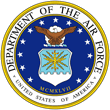Warfighting integration, cyberspace expands service's reach
WASHINGTON (AFPN) --
Shortening the "kill chain" and enabling commanders to make well-informed decisions are a priority for the Air Force, said the chief of warfighting integration at the recent Air Force Information Technology Day here.
Technology and cyberspace are the two top components for that priority, said Lt. Gen. Michael W. Peterson, who is also the chief of information for the secretary of the Air Force.
"It's not so much new technology that's allowing us to achieve a different level of impact," he said. "It's a combination of space, air and ground assets that bring a lethal mixture of precision and speed to the war on terrorism."
The Air Force uses a six-stage target cycle, or "kill chain", of find, fix, track, target, engage and assess when striking targets in a war zone. The cycle starts when an enemy target is identified and the information collected is submitted up the chain of command for approval to strike.
Information is collected from all possible resources, such as streamlined video from unmanned aircraft, ground forces observations or satellite images, all of which are gathered at different locations around the world and funneled to the commanders who base their decisions on the data.
"Back in 1991 during the first Gulf War, we couldn't deploy our assets rapidly enough," General Peterson said. "We could see Saddam Hussein's scud missiles on the radar. We could track them. But we couldn't process the information to the commander to authorize an attack fast enough. In 1999, during Allied Force, technology was a little better, but again, speed was an issue. Images from the U-2 (reconnaissance aircraft) had to be sent to Beale (Air Force Base, Calif.), then to Offutt (AFB, Neb.), back to the Combined Air Operations Center in Vicenza, Italy before a decision was made to deploy a fighter from Aviano (AB, Italy) to drop a bomb. That took 4.5 hours."
Advances in technology and the streamlining of the "kill chain" process has shaved the process down to minutes, but it's also brought about a new frontline to the war on terrorism that requires protection.
"As much as we depend on the Internet and other cyberspace resources, it is crucial that we have the means and the knowledge to protect it," said General Peterson, referring to the Provisional Cyberspace Command at Barksdale AFB, La.
"In some ways, cyberspace could be our Achilles' heel, so we start by looking at network defense," he said. "We need to create a generation of Airmen who can defend the network. We need to know our enemies capabilities too, and protect (against) their intrusion and ensure the information isn't infiltrated. At the same time, we need to understand vulnerabilities and cut them off so they cannot enjoy some of the freedoms we do."
Comment on this story (comments may be published on Air Force Link)
View the comments/letters page
Technology and cyberspace are the two top components for that priority, said Lt. Gen. Michael W. Peterson, who is also the chief of information for the secretary of the Air Force.
"It's not so much new technology that's allowing us to achieve a different level of impact," he said. "It's a combination of space, air and ground assets that bring a lethal mixture of precision and speed to the war on terrorism."
The Air Force uses a six-stage target cycle, or "kill chain", of find, fix, track, target, engage and assess when striking targets in a war zone. The cycle starts when an enemy target is identified and the information collected is submitted up the chain of command for approval to strike.
Information is collected from all possible resources, such as streamlined video from unmanned aircraft, ground forces observations or satellite images, all of which are gathered at different locations around the world and funneled to the commanders who base their decisions on the data.
"Back in 1991 during the first Gulf War, we couldn't deploy our assets rapidly enough," General Peterson said. "We could see Saddam Hussein's scud missiles on the radar. We could track them. But we couldn't process the information to the commander to authorize an attack fast enough. In 1999, during Allied Force, technology was a little better, but again, speed was an issue. Images from the U-2 (reconnaissance aircraft) had to be sent to Beale (Air Force Base, Calif.), then to Offutt (AFB, Neb.), back to the Combined Air Operations Center in Vicenza, Italy before a decision was made to deploy a fighter from Aviano (AB, Italy) to drop a bomb. That took 4.5 hours."
Advances in technology and the streamlining of the "kill chain" process has shaved the process down to minutes, but it's also brought about a new frontline to the war on terrorism that requires protection.
"As much as we depend on the Internet and other cyberspace resources, it is crucial that we have the means and the knowledge to protect it," said General Peterson, referring to the Provisional Cyberspace Command at Barksdale AFB, La.
"In some ways, cyberspace could be our Achilles' heel, so we start by looking at network defense," he said. "We need to create a generation of Airmen who can defend the network. We need to know our enemies capabilities too, and protect (against) their intrusion and ensure the information isn't infiltrated. At the same time, we need to understand vulnerabilities and cut them off so they cannot enjoy some of the freedoms we do."
Comment on this story (comments may be published on Air Force Link)
View the comments/letters page
